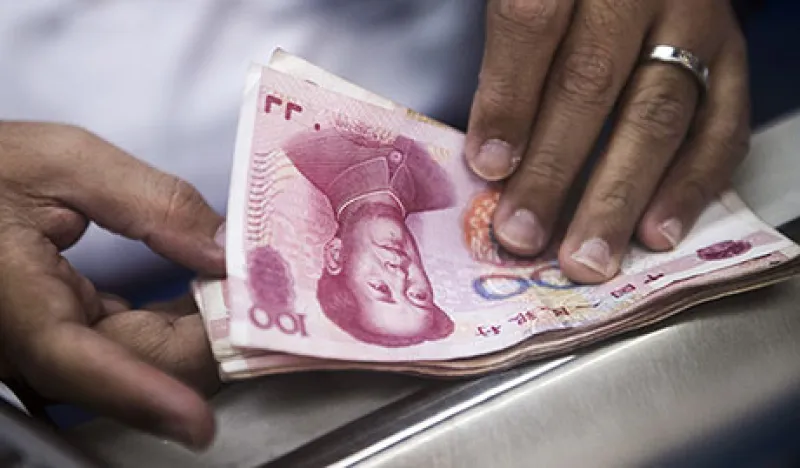January’s market turmoil has very little to do with China but a lot to do with the U.S. The trigger? U.S. interest rates. The dollar is considered a safe haven and is widely expected to rise further. Yet the currency is in a bubble and may soon fall. The signal of when dollar weakness will start will come from China.
We have in front of us an example of one of the most interesting features of modern finance. Market participants have different models of reality to explain events. When mass adherence to a model switches, it can cause sudden market moves — crisis even. The dynamics of such a change in beliefs have driven some of the largest moves ever in asset prices. A key in guessing possible futures is to know what the different views are and who holds them: mapping the structure of investor bases but also the beliefs of different investor types.
There are two major global structural problems: overindebtedness in the developed world and imbalances in the international monetary system. These issues were at the root of the 2008 financial crisis, and they have not yet been fixed. The second problem helped cause the first: Asian savings pushed down the U.S. yield curve and encouraged excessive borrowing. This, on top of lax regulation, led to the 2008 crisis.
Because government intervention was not sufficient, the Federal Reserve saw itself as the only institution between the U.S. economy and full-on depression. A radical, untried program — quantitative easing — was instigated to provide liquidity to banks and push up asset prices so that banks could recapitalize themselves. This action was taken to avoid depression. But to admit as such may itself have caused uncertainty and risked a depression. So central banks have made a distinction between maximum and optimal transparency. They are misleading markets deliberately. Markets haven’t fully understood this yet.
One result of QE has been the large inventory cycle in the U.S. Optimistic firms stock up, only to be disappointed. Hence, we have seen a repeated pattern of healthy growth for a quarter or two, followed by near-zero the next. The data do not indicate strong U.S. recovery yet, although the judicious choice of base time periods continues to fool many. Quantitative easing may have prevented depression, but it did not stimulate the U.S. economy. Consumer prices have remained flat.
The enormous liquidity that is quantitative easing has, however, inflated asset prices, principally in developed markets and the dollar. Central banks that haven’t been injecting liquidity — such as those in emerging markets — have seen their currencies fall versus the dollar, but not because of any sense of crisis.
The International Monetary Fund was warning of excessive dollar strength and the risk of renewed recession, should the Federal Reserve raise interest rates. The Fed, however, in December had no more excuses not to raise rates. The turmoil we are now seeing was triggered by investors starting to doubt their previous faith in the U.S. recovery.
What happens next? The renminbi had been pegged to the dollar and so had been appreciating. Its depegging was not motivated by trade competitiveness but so as to prepare the renminbi as an alternative reserve currency. Yes, there was an exit of money when the peg went in August. That was always going to happen, given the very high money supply in the Chinese economy — a side effect of the post-2008 credit boom. Limited choice in financial instruments, as well as a homogenous investor base structure and beliefs, has further added to short-term volatility.
The last time there were major imbalances in the international monetary system was in the 1960s. The U.S. amassed liabilities that significantly exceeded the amount of gold backing the greenback under the Bretton Woods system. The creditor countries at the time — in Western Europe — lost patience with the U.S. in 1971 and then-president Richard Nixon was forced to abandon gold convertibility. What came to be known in economic history as the Nixon shock has been painted as a U.S. choice, but it wasn’t much of one. Nixon could have decided to come off the gold standard and keep the country’s gold stock or be forced off the standard once all the gold had gone. The dollar fell from $35 an ounce after reaching a brief low of $194 an ounce in 1974. Chaos, and a decade of inflation then ensued.
Fortunately, today, with the U.S. as the main debtor again but emerging markets the main creditors, a more gradual adjustment in the international monetary system is possible, indeed likely. Emerging-markets central banks and other creditors do not want to be last to ditch depreciating dollars, but neither do they want to be first, damaging short-term trade competitiveness. Hence, they are motivated to follow China’s lead. Once China’s currency market has steadied in the coming weeks or months, we should expect, maybe after a brief pause, the renminbi’s reserve currency status to build, and widespread appreciation of EM currencies against the dollar.
Jerome Booth is the co-founder of emerging-markets investment management firm Ashmore Group and, following his retirement in 2013, continues to invest via his London-based private office, New Sparta Asset Management . He is also the author of Emerging Markets in an Upside Down World: Challenging Perceptions in Asset Allocation and Investment , published in 2014.






